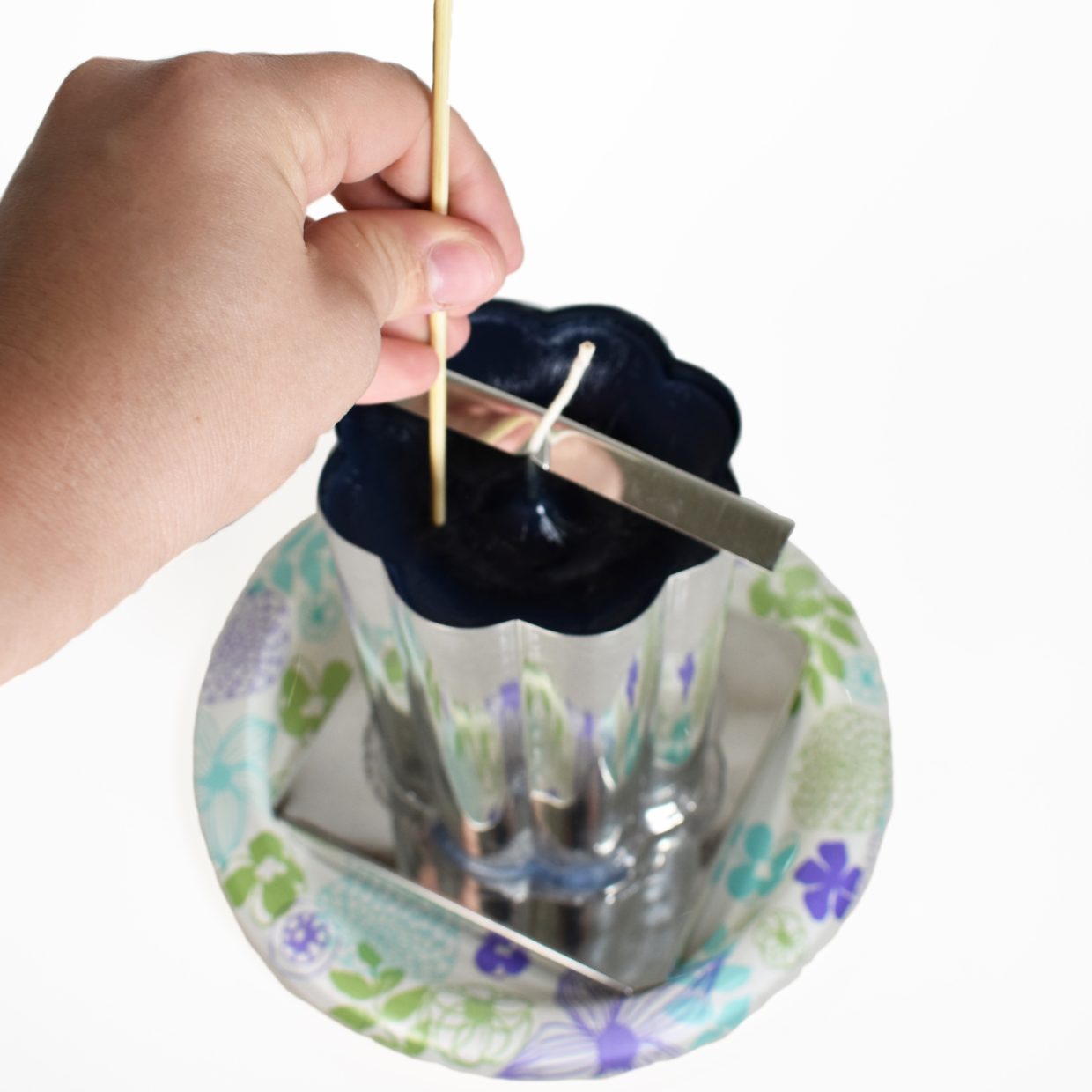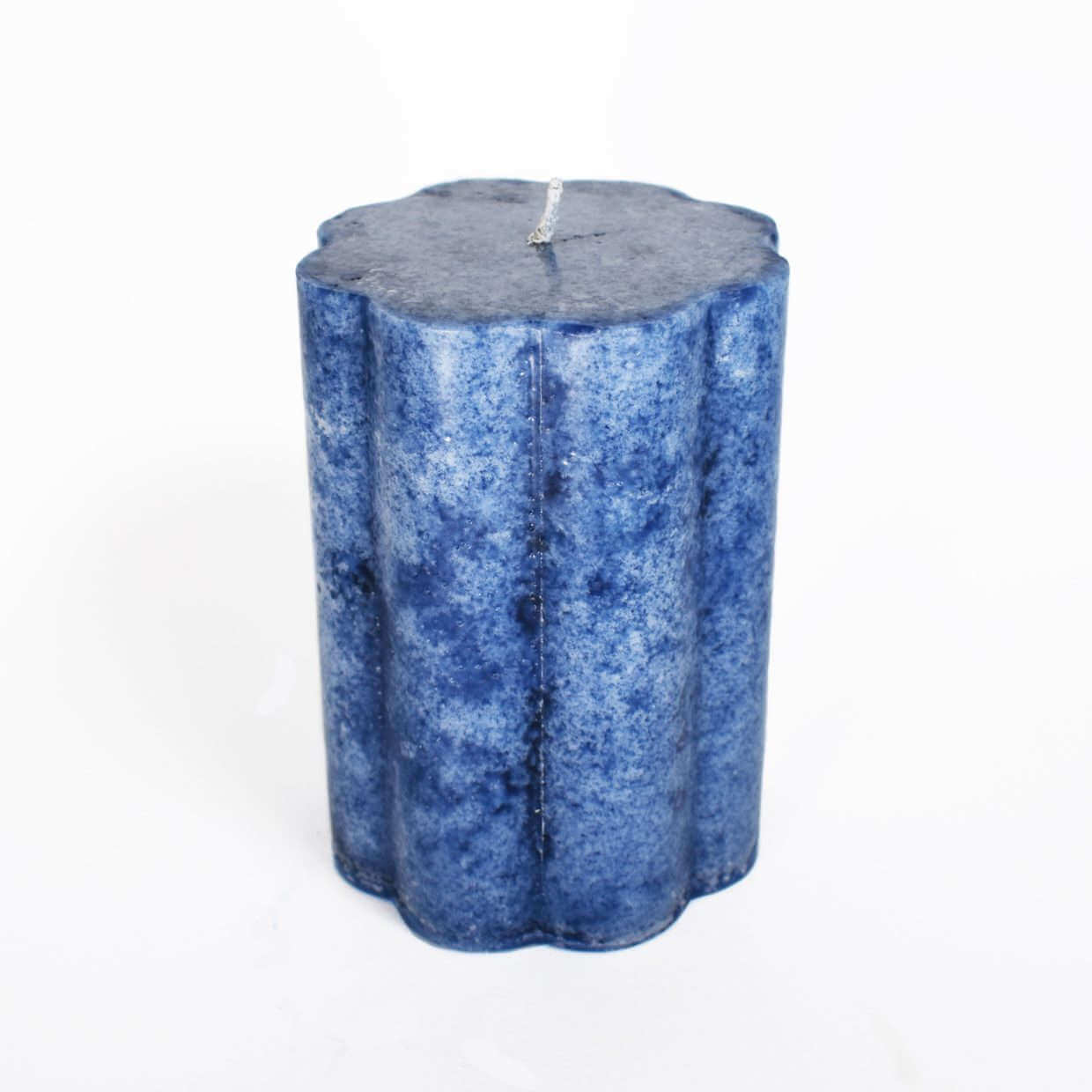How to Make Pillar Candles
Start by gathering all the items that you will need. Our Pillar Candle Starter Kit contains many of the items found in this tutorial. The Candle making process will go much more smoothly if everything is readily accessible.

Here's What You'll Need:
Mold Putty
Cookie Sheet or Pan
Skewer
Utility Knife or Putty Knife
UV Stabilizer (optional, but recommended)
Butcher Paper or Newspaper
Paper Towels
Metal Spoon or Stir Stick
Sauce Pan
Scissors or Nail Clippers
Metal Cookie Cutter or Trivet

Step 1
For this project, IGI 1274 was used, which is a mottling wax so the outcome will be slightly different, but it has been discontinued and we recommend using IGI 4625. Cutting this type of wax can be tricky. For this demonstration, the wax is cut with a putty knife but you may need to use another method if your wax is too hard. First, score the wax with a utility knife. Then take the scored piece of wax and hang it off the edge of a table or countertop. Pressure is then applied to help break the wax on the score. You may need to do this a few times to get the wax into small enough pieces to fit in the pouring pot. (Be careful not to cut yourself or smash your fingers while doing this.) The wax can be weighed in the pouring pot so you do not have to transfer it from a different container.

Step 2
The wax will need to be heated to 180° in a double boiler. To create a double boiler, put about an inch of water in the sauce pan, and then place the pouring pot in the water. It is a good idea to add an inexpensive metal trivet or cookie cutter under the pouring pot to elevate it. Doing this ensures the wax is not receiving direct heat from any side. Adjust the heat to a medium-low setting. The water needs to be boiling, but it does not have to come to a rolling boil. If the water is at a rolling boil, it may splatter out of the pan. Check the temperature of the wax occasionally to make certain it is not getting too hot. Adjust the temperature as needed. While the wax is melting you can continue with the next steps, but make sure that the wax is never left unattended.

Step 3
While the wax is melting, you can prepare your mold(s). Even when the molds are new, there may be a thin layer of oil in them from the manufacturing process. Your candles will look best if the wax is poured into clean molds. To clean them, put a small amount of mold cleaner on a paper towel, and then wipe the inside of the molds thoroughly. If you do not have mold cleaner available, a Pam type cooking spray would also work. The wick can be put in the mold before the wax is poured into it. To do this, cut the length of wick that you need. (It is better to have too much than not enough, so you might add about 6 inches to the height of your mold. As you are more comfortable making pillars, you may find you can adjust that down.) String the wick through the hole in the bottom of the mold leaving a few inches of wicking hanging out.

Step 4
Take the wick and hold it flush to the bottom of the mold. Next, take a piece of your putty or sticky tack, roll it into a ball, and press it firmly into the bottom of the mold. You'll want to smooth out the edges of the putty so that you get a good seal and so your mold will sit flush to your surface. If the mold putty is not added, wax will leak from the bottom.

Step 5
After you have secured your wick at the bottom, turn your mold over and use the wick bar to anchor the wick at the top of the mold. The wick should be pulled tight so there is no slack in it. Slide the wick into the slit in the wick bar. Since there is a chance the wax can leak from the bottom of the mold, place the mold in a pan or paper plate so any possible leaks will be contained.

Step 6
Once the wax has reached the proper temperature, you are ready to add the fragrance oil. Depending on the wax you are using, you could add 0.5 – 1.0 ounce of fragrance per pound of wax. It is most common to add 1 ounce of fragrance per pound of wax. The fragrance is most accurately measured by weight, but you can also use a tablespoon to measure it if the scale you have does not measure a small amount precisely. A tablespoon is equal to 0.5 ounce. Pour the fragrance into the wax and stir it.

Step 7 (using dye blocks)
Next, add the desired amount of dye. If using dye blocks, the block will melt into the wax more quickly if it is cut into small pieces. After adding the desired amount, stir the mixture until it is blended thoroughly. Skip to step 9 if you are using dye blocks.

Step 7 (using liquid dye)
If using liquid dyes, just add the desired amount of drops. Since you can not remove dye once it has been added, it should be added sparingly, especially if you are trying to achieve a light color. You can always add a little more if it is not dark enough. After adding the desired amount, stir the mixture until it is blended thoroughly.

Step 8
When you look at the liquid wax, it will usually look much darker than when it has completely cooled. To test the color, you can drip a small amount of wax onto a paper plate or paper towel. (Make sure not to drip the hot wax on your hands). Allow it to harden, and you will be able to see a more accurate representation of the color. You can then add more dye if desired.

Step 9
At this point, you can add UV stabilizer if you choose. The addition of UV stabilizer will help keep the color from fading if the candles are exposed to UV rays or fluorescent lighting. You would add about ½ teaspoon per pound of wax. Mix everything together very thoroughly. Mixing it for 3 – 5 minutes would be best. Check the temperature again to make sure it is between 175° - 185°F. Remove the pouring pot from the double boiler. The handle of the pouring pot may heat up slightly, so be sure to use a hot pad or something to protect your hand. You may also want to set the pouring pot on a few paper towels to absorb the water from the double boiler.

Step 10
Remove the pouring pot from the double boiler. The handle of the pouring pot may heat up slightly, so be sure to use a hot pad or something to protect your hand. You may also want to set the pouring pot on a few paper towels to absorb the water from the double boiler. Stir the wax mixture occasionally as you prepare your containers.

Step 11
Check your temperature again to make sure it has not cooled down too much. For this wax, it is recommended to pour between 185-200 degrees. Slowly pour the wax into the mold. If you pour too quickly, it may cause bubbles to form on top of the wax. The wax can be poured level with the top of the mold. After filling the mold, there should be some wax left in your pouring pot. You will need this wax for the second pour.

Step 12
As the wax starts to set, you will need to make relief holes in the candle. Relief holes are holes that are poked in candles to release air pockets that form as the wax cools and shrinks. This helps prepare the candle for the second pour.When you can see a “skin” has formed across the wax, use the skewer to poke relief holes. One on each side of the wick will be sufficient. Make sure you poke them deep into the candle, but take care not to hit the side of the mold. If you touch the side, you may scar your candle. You also want to make them large enough to make a “tunnel” for your second pour. You will do this several times as the wax is cooling. You will not do the second pour until the wax from the first pour has completely set.

Step 13
When you are ready to do the second pour, reheat the leftover wax to about 185°F. Fill in the holes that you have made in the candle so that the second pour is level with the first pour. If you fill past the level of the first pour, you will likely see a “seam” line on your finished candle.

Step 14
Once the second pour has completely set, you are ready to remove the candle from the mold. You will need to remove the mold putty and screw from the bottom of the mold first. After you have removed the screw and the putty, gently slide the mold off of the candle. If you are having trouble removing it, you can put it in the freezer for about 5 minutes to help the wax release from the mold. If you still have trouble after putting it in the freezer, you can put it in the freezer for an additional 5 minutes. Be sure not to leave it in the freezer too long or your candle could crack, and it could fall apart when removed from the mold. You can use the wick as leverage to help remove the candle, but be careful not to pull too hard on the wick as it may break or come out of the candle.
Trim the wick to ¼” length using wick trimmers, scissors or nail clippers. Be sure not to trim it too short because it will not burn properly. It is highly recommended to add a caution label. You may also choose to add labels unique to your business, fragrance name labels, or other packaging.

That's it!
Are you ready to give it a try?
Our Pillar Candle Starter Kit is a great way to get everything you need to start making candles or you may choose to order everything you need separately by browsing our selection of candle making supplies.
Tag us if you share your creations on your social media accounts! You can use the hashtag #lonestarcommunity and see your beautiful creations on our Lone Star Community page.